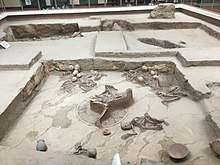Lajia
Lajia (Chinese: 喇家; pinyin: Lǎjiā) is an archaeological site located in Minhe County, Haidong Prefecture in Northwest China's Qinghai province. Lajia is associated with the Qijia culture and was discovered by archaeologists in 2000. The site covers an area of around 200,000 square meters.

喇家 | |
 | |
 Location within Qinghai | |
| Location | China |
|---|---|
| Region | Qinghai |
| Coordinates | 35.86405°N 102.81025°E |
| History | |
| Cultures | Qijia |
| Events | Earthquake Mudslide Flood |
| Site notes | |
| Excavation dates | 1999, 2000, 2001, 2002, 2003, 2004[1] |
| Management | Lajia Site Museum |
In 2002,[2] the oldest intact noodles yet discovered were located at Lajia, estimated at over 4,000 years old.[3] The noodles were made from foxtail and broomcorn millet.
A study of the site's faunal remains revealed that sheep were the most common domesticated species in the area, followed by pigs and cattle. The remains suggest that sheep may have been exploited for meat at the site, rather than for wool or milk [4]
Destruction
Archaeologists think the site was abandoned after being devastated by an earthquake and subsequent flood.
In 2000, Bronze Age buildings were found destroyed by a mudslide that had been triggered by an earthquake in the north-east part of the site.[1] 14 people had apparently taken refuge inside two of these buildings.[1] The skeletons of the victims were preserved in situ and were displayed as found in the Lajia Museum in 2015.[5]
Red soils brought by the Yellow River flooding were also found in the site's north-east.[1]
References
- Ye, Maolin (28 April 2005). "Archaeological discoveries at the Lajia site, Minhe County, Qinghai Province". Chinese Archaeology. Retrieved 3 January 2017.
- Ye, Maolin; Lu, Houyuan. "The earliest Chinese noodles from Lajia". The Institute of Archaeology. Chinese Academy of Social Sciences. Retrieved 12 October 2011.
- Oldest noodles found in China, BBC News,12 October 2005
- https://dspace.library.uvic.ca/handle/1828/5300
- "Shocking scenes found in 4000-year-old earthquake relic". People's Daily Online. 8 August 2015. Retrieved 30 January 2017.
Further reading
- Wu, Qinglong; Zhao, Zhijun; Liu, Li; Granger, Darryl E.; Wang, Hui; Cohen, David J.; Wu, Xiaohong; Ye, Maolin; Bar-Yosef, Ofer; Lu, Bin; Zhang, Jin; Zhang, Peizhen; Yuan, Daoyang; Qi, Wuyun; Cai, Linhai; Bai, Shibiao (2016). "Outburst flood at 1920 BCE supports historicity of China's Great Flood and the Xia dynasty". Science. 353 (6299): 579–582. doi:10.1126/science.aaf0842. PMID 27493183.
- Normile, Dennis (2016). "Massive flood may have led to China's earliest empire". Science. American Association for the Advancement of Science. doi:10.1126/science.aag0729. Retrieved 5 August 2016.
- Wu, Wenxiang; Dai, Junhu; Zhou, Yang; Ge, Quansheng (2017). "Comment on 'Outburst flood at 1920 BCE supports historicity of China's Great Flood and the Xia dynasty'". Science. 355 (6332): 1382. doi:10.1126/science.aal1278. PMID 28360291.
- Han, Jian-Chiu (2017). "Comment on 'Outburst flood at 1920 BCE supports historicity of China's Great Flood and the Xia dynasty'". Science. 355 (6332): 1382. doi:10.1126/science.aal1369. PMID 28360292.
- Huang, Chun Chang; Zhou, Yali; Zhang, Yuzhu; Guo, Yongqiang; Pang1, Jiangli; Zhou, Qiang; Liu, Tao; Zha, Xiaochun (2017). "Comment on 'Outburst flood at 1920 BCE supports historicity of China's Great Flood and the Xia dynasty'". Science. 355 (6332): 1382. doi:10.1126/science.aak9657. PMID 28360293.
- Wu, Qinglong; Zhao, Zhijun; Liu, Li; Granger, Darryl E.; Wang, Hui; Cohen, David J.; Wu, Xiaohong; Ye, Maolin; Bar-Yosef, Ofer; Lu, Bin; Zhang, Jin; Zhang, Peizhen; Yuan, Daoyang; Qi, Wuyun; Cai, Linhai; Bai, Shibiao (2017). "Response to comments on 'Outburst flood at 1920 BCE supports historicity of China's Great Flood and the Xia dynasty'". Science. 355 (6332): 1382. doi:10.1126/science.aal1325. PMID 28360294.